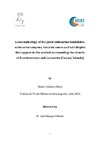Identificador persistente para citar o vincular este elemento:
https://accedacris.ulpgc.es/jspui/handle/10553/75240
| Campo DC | Valor | idioma |
|---|---|---|
| dc.contributor.advisor | Mangas Viñuela, José | - |
| dc.contributor.advisor | Acosta Yepes, Juan | - |
| dc.contributor.author | Cuñarro Otero, Daniel | - |
| dc.date.accessioned | 2020-11-05T14:46:04Z | - |
| dc.date.available | 2020-11-05T14:46:04Z | - |
| dc.date.issued | 2014 | en_US |
| dc.identifier.uri | https://accedacris.ulpgc.es/handle/10553/75240 | - |
| dc.description.abstract | This study is about the geomorphology of giant submarine landslides, insular shelf scarps, submarine canyons, volcanic cones and salt diapirs that can be found on the seafloor around the islands of Fuerteventura and Lanzarote (Canary Islands). We are using multibeam echosounder data taken during oceanographic surveys made by the Spanish Institute of Oceanography (IEO) and the Hydrographic Institute of the Navy (IHM). In order to analyse these data we employ Geographical Information System (GIS) software. Two giant submarine landslides called ‘Puerto del Rosario’, with an area of 3,843 km2, and ‘Southern Puerto del Rosario’, with an area of 2,387 km2, are located on the western side of Fuerteventura. The first one is the largest submarine landslide deposit ever found in the Canary Islands and holds several exotic blocks; one measuring 22 km in length and a minimum volume of 66 km3. We delimited sixteen scarps, from 5 to 20 km length, which are often the headwall of submarine canyons and which are related to submarine landslide processes occurred on the shelf break and upper slope. We also delimited many kilometric submarine canyons, with lengths from 3 to 71 km, on both sides of the islands. These canyons are more developed (i.e., longer, more sinuous and with more tributaries) on the western side of Fuerteventura and Lanzarote. In the ramp west of Lanzarote, ten volcanic cones have been measured and identified. They are 70-250 m high and between 2 and 11 km2 in area and they are probably related to recent volcanism in Lanzarote. At least twelve salt diapirs are found in the east side of the islands of Fuerteventura and Lanzarote. The salt domes are related to evaporite deposits formed in the Proto-Atlantic Ocean during the Late Triassic. The studied diapirs range from 60 to 340 m height, from 5 to 63 km2 in area, and from 0.15 to 16 km3 in volume. They show a NE-SW alignment and are located in a range of 1,000-1,500 m depth. | en_US |
| dc.language | eng | en_US |
| dc.subject | 250607 Geomorfología | en_US |
| dc.title | Geomorphology of the giant submarine landslides, submarine canyons, volcanic cones and salt diapirs that appear in the seabed surrounding the islands of Fuerteventura and Lanzarote (Canary Islands) | en_US |
| dc.type | info:eu-repo/semantics/masterThesis | en_US |
| dc.type | MasterThesis | en_US |
| dc.contributor.departamento | Física | en_US |
| dc.contributor.facultad | Facultad de Ciencias del Mar | en_US |
| dc.investigacion | Ciencias | en_US |
| dc.type2 | Trabajo final de máster | en_US |
| dc.description.notas | Máster en Oceanografía ; 2013-2014 | en_US |
| dc.utils.revision | Sí | en_US |
| dc.identifier.matricula | TFT-29444 | es |
| dc.identifier.ulpgc | Sí | en_US |
| dc.contributor.buulpgc | BU-BAS | en_US |
| dc.contributor.titulacion | Máster Universitario en Oceanografía | es |
| item.grantfulltext | restricted | - |
| item.fulltext | Con texto completo | - |
| crisitem.advisor.dept | GIR IOCAG: Geología Aplicada y Regional | - |
| crisitem.advisor.dept | IU de Oceanografía y Cambio Global | - |
| crisitem.advisor.dept | Departamento de Física | - |
| Colección: | Trabajo final de máster Restringido ULPGC | |
Visitas
86
actualizado el 31-dic-2023
Descargas
26
actualizado el 31-dic-2023
Google ScholarTM
Verifica
Comparte
Exporta metadatos
Los elementos en ULPGC accedaCRIS están protegidos por derechos de autor con todos los derechos reservados, a menos que se indique lo contrario.
